Investigation of Transport and Transformation of Tropospheric Ozone in Terrestrial Ecosystems of the Coastal Zone of Lake Baikal
Abstract
1. Introduction
2. Experiments
2.1. Atmosphere Experiments—Grasslands
2.2. Atmosphere Experiments—Forest
3. Results and Discussion
3.1. Gradient Measurements of Ozone
3.2. Flux of Ozone to the Underlying Surface
4. Conclusions
Author Contributions
Funding
Conflicts of Interest
References
- Perov, S.P.; Khrgyaan, A.K.H. Current Problems of Atmospheric Ozone, 3rd ed.; Hydromet: Leningrad, Russia, 1980; pp. 134–156. [Google Scholar]
- Treshou, M. Air Pollution and Plant Life, 3rd ed.; Hydromet: Leningrad, Russia, 1988; pp. 356–360. [Google Scholar]
- Belan, B.D. Ozone in the Troposphere; Institute of Atmosphere Optics SB RUS: Tomsk, Russia, 2010; p. 487. (In Russian) [Google Scholar]
- Shimarev, M.N.; Kuimova, L.N.; Sinyokovich, V.N.; Tsekhanovskiy, V.V. On the manifestation on Baikal of global climate change in the twentieth century. Dokl. Ran 2002, 383, 397–400. [Google Scholar]
- Demin, V.I.; Beloglazov, M.I.; Mokrov, E.G. Foehn effects above Khibiny in changes of surface ozone concentration. Atmos. Ocean. Opt. 2005, 18, 613–617. [Google Scholar]
- Demin, V.I.; Beloglazov, M.I. On the influence of local circulation processes on surface ozone dynamics. Atmos. Ocean. Opt. 2004, 17, 331–333. [Google Scholar]
- Zayakhanov, A.S.; Zhamsueva, G.S.; Tsydypov, V.V.; Balzhanov, T.S. Results of monitoring or surface ozone in atmosphere of Ulan-Ude. Meteorol. Hydrol. 2013, 12, 76–84. [Google Scholar] [CrossRef]
- Zayakhanov, A.S.; Zhamsueva, G.S.; Tsydypov, V.V.; Balzhanov, T.S. The influence of dynamic processes on the variations of ozone and other small gas impurities near the coastal zone of Lake Baikal. Atmos. Ocean. Opt. 2015, 28, 505–511. [Google Scholar]
- Zayakhanov, A.S.; Zhamsueva, G.S.; Tsydypov, V.V.; Balzhanov, T.S. Daily dynamics of ozone and other small gas impurities in the coastal zone of Lake Baikal (station Boyarsky). Meteorol. Hydrol. 2017, 8, 85–92. [Google Scholar]
- Clark, D.A.; Clark, D.B. Assessing tropical forests climatic sensitivities with longterm data. Biotropica 2011, 43, 31–40. [Google Scholar] [CrossRef]
- Stocker, T.F.; Qin, D.; Plattner, G.K.; Tignor, M.; Allen, S.K.; Boschung, J.; Midgley, B.M. Сlimate Change 2013: The Physical Science Basis. Contribution of Working Group I to the fifth Assessment Report of the Intergovernmental Panel on Climate Change; Cambridge University Press: Cambridge, UK; New York, NY, USA, 2013. [Google Scholar]
- Malhi, Y.; Baldocci, D.D.; Jarvis, P.G. The carbon balance of tropical, temperate and boreal forests. Plant Cell Environ. 1999, 22, 715–740. [Google Scholar] [CrossRef]
- Falge, E.; Tenhunen, J.; Baldocchi, D.; Aubinet, M.; Bakwin, P.; Berbigier, P.; Bernhofer, C.; Bonnefond, J.M.; Burba, G.; Clement, R.; et al. Phase and amplitude of ecosystem carbon release and upt ake potentials as derived from FLUXNET measurements. Agric. For. Meteorol. 2002, 113, 75–95. [Google Scholar] [CrossRef]
- Granados, J. Tropical Forest Response to Climate Change; Springer: Berlin/Heidelberg, Germany, 2006. [Google Scholar]
- Rudnev, N.I. The Environment-Forming Role of Vegetation in Tropical and Temperate Latitudes of Eurasia; Institute of Ecology and Evolution RUS: Moscow, Russia, 2003; p. 32. (In Russian) [Google Scholar]
- Luyssaert, S.; Schulze, E.D.; Borner, A.; Knohl, A.; Hessenmoller, D.; Law, B.E.; Ciais, P.H.; Grace, J. Old-growth forests as global carbon sinks. Nature 2008, 455, 213–215. [Google Scholar] [CrossRef]
- Loreto, F.; Fares, S. Is ozone flux inside leaves only a damage indicator? Clues from volatile isoprenoid studies. Plant Physiol. 2007, 143, 1096–1100. [Google Scholar] [CrossRef] [PubMed]
- Pell, E.J.; Schlagnhaufer, C.D.; Arteca, R.N. Ozone-induced oxidative stress: mechanisms of action and reaction. Physiol Plant. 1997, 100, 264–273. [Google Scholar] [CrossRef]
- Olofsson, J.; Oksanen, L.; Oksanen, T.; Tuomi, M.; Hoset, K.S.; Virtanen, R.; Kyrö, K. Long-Term Experiments Reveal Strong Interactions between Lemmings and Plants in the Fennoscandian Highland Tundra. Ecosystems 2014, 17, 606–615. [Google Scholar] [CrossRef]
- Laysk, A.K. Kinetics of C3 Plant Photosynthesis; Nauka: Moscow, Russia, 1991; p. 22. [Google Scholar]
- Finlayson-Pitts, B.J.; Pitts, J.N. Chemistry of the Upper and Lower Atmosphere. Theory, Experiments, and Application; Academic Press. Elsevier Inc.: London, UK, 2000; p. 993. [Google Scholar]
- Braun, S.; Schindler, C.; Rihm, B. Growth losses in Swiss forests caused by ozone: Epidemiological data analysis of stem increment of Fagus sylvatica L. and Picea abies Karst. Environ. Pollut. 2014, 192, 129–138. [Google Scholar] [CrossRef] [PubMed]
- Juráň, S.; Edwards-Jonášová, M.; Cudlín, P.; Zapletal, M.; Šigut, L.; Grace, J.; Urban, O. Prediction of ozone effects on net ecosystem production of Norway spruce forest. iForest 2018, 11, 743–750. [Google Scholar] [CrossRef]
- Meyers, T.P.; Hall, M.E.; Lindberg, S.E.; Kim, K. Use of the modified Bowen-ratio technique to measure fluxes of trace gases. Atmos. Environ. 1996, 30, 3321–3329. [Google Scholar] [CrossRef]
- Park, J.H.; Fares, S.; Weber, R.; Goldstein, A.H. Biogenic volatile organic compound emissions during BEARPEX 2009 measured by eddy covariance and flux-gradient similarity methods. Atmos. Chem. Phys. 2014, 14, 231–244. [Google Scholar] [CrossRef]
- Munger, J.W.; Wofsy, S.C.; Bakwin, P.S.; Fan, S.M.; Goulden, M.L.; Daube, B.C.; Goldstein, A.H.; Moore, K.E.; Fitzjarrald, D.R. Atmospheric deposition of reactive nitrogen oxides and ozone in a temperate deciduous forest and a subarctic woodland: 1. Measurements and mechanisms. J. Geophys. Res. 1996, 101, 12639–12657. [Google Scholar] [CrossRef]
- Urbanski, S.; Barford, C.; Wofsy, S.; Kucharik, C.; Pyle, E.; Budney, J.; McKain, K.; Fitzjarrald, D.; Czikowsky, M.; Munger, J. Factors controlling CO2 exchange on timescales from hourly to decadal at Harvard Forest. J. Geophys. Res. 2007, 112. [Google Scholar] [CrossRef]
- Wu, Z.Y.; Zhang, L.; Wang, X.M.; Munger, J.W. A modified micrometeorological gradient method for estimating O3 dry depositions over a forest canopy. Atmos. Chem. Phys. 2015, 15, 7487–7496. [Google Scholar] [CrossRef]
- Wesely, M.; Hicks, B. A review of the current status of knowledge on dry deposition. Atmos. Environ. 2000, 34, 2261–2282. [Google Scholar] [CrossRef]
- Pleim, J.; Ran, L. Surface flux modeling for air quality applications. Atmosphere 2011, 2, 271–302. [Google Scholar] [CrossRef]
- Flechard, C.R.; Nemitz, E.; Smith, R.I.; Fowler, D.; Vermeulen, A.T.; Bleeker, A.; Erisman, J.W.; Simpson, D.; Zhang, L.; Tang, Y.S.; et al. Dry deposition of reactive nitrogen to European ecosystems: a comparison of inferential models across the NitroEurope network. Atmos. Chem. Phys. 2011, 11, 2703–2728. [Google Scholar] [CrossRef]
- Schwede, D.; Zhang, L.; Vet, R.; Lear, G. An intercomparison of the deposition models used in the CASTNET and CAPMoN networks. Atmos. Environ. 2011, 45, 1337–1346. [Google Scholar] [CrossRef]
- Matsuda, K.; Watanabe, I.; Wingpud, V.; Theramongkol, P.; Ohizumi, T. Deposition velocity of O3 and SO2 in the dry and wet season above a tropical forest in northern Thailand. Atmos. Environ. 2006, 40, 7557–7564. [Google Scholar] [CrossRef]
- Wu, Z.Y.; Wang, X.M.; Chen, F.; Turnipseed, A.A.; Guenther, A.B.; Niyogi, D.; Charusombat, U.; Xia, B.C.; Munger, J.W.; Alapaty, K. Evaluating the calculated dry deposition velocities of reactive nitrogen oxides and ozone from two community models over a temperate deciduous forest. Atmos. Environ. 2011, 45, 2663–2674. [Google Scholar] [CrossRef]
- O’Dell, R.A.; Tahcri, M.; Kabel, R.L. A model for uptake of pollutants by vegetation. J. Air Pollut. Control Assoc. 1977, 27, 1104–1109. [Google Scholar] [CrossRef]
- Wesely, M.L.; Eastman, J.A.; Cook, D.R.; Hicks, B.B. Daytime variations of ozone eddy fluxes to maize. Bound. Lay Meteorol. 1978, 15, 361–373. [Google Scholar] [CrossRef]
- Leuning, R.; Neumann, H.H.; Thurtell, G.W. Ozone uptake by corn: a general approach. Agric. Meteorol. 1979, 20, 115–136. [Google Scholar] [CrossRef]
- Galbally, I.E.; Roy, C.R. Destruction of ozone at the earth’s surface. Q. J. Roy. Met. Soc. 1980, 599–620. [Google Scholar] [CrossRef]
- Padro, J.; Zhang, L.; Massman, W.J. An analysis of measurements and modelling of air-surface exchange of NO-NO2-O3 over grass. Atmos. Environ. 1998, 32, 1365–1375. [Google Scholar] [CrossRef]
- Meyers, T.P.; Finkelstein, P.L.; Clarke, J.; Ellestad, T.G.; Sims, P.F. A multi-layer model for inferring dry deposition using standard meteorological measurements. J. Geophy. Res. 1998, 103, 22645–22661. [Google Scholar] [CrossRef]
- Wu, Y.; Brashers, B.; Finkelstein, P.L.; Pleim, J.E. A multilayer biochemical dry deposition model, 1. Model formulation. J. Geophy. Res. 2003, 108, ACH 1-1–ACH 1-12. [Google Scholar] [CrossRef]
- Zhang, B.; Owen, R.C.; Perlinger, J.A.; Kumar, A.; Wu, S.; Martin, M.V.; Kramer, L.; Helmig, D.; Honrath, R.E. A semi-Lagrangian view of ozone production tendency in North American outflow in the summers of 2009 and 2010. Atmos. Chem. Phys. 2014, 14, 2267–2287. [Google Scholar] [CrossRef]
- Baldocchi, D. A multi-layer model for estimating sulfur dioxide deposition to a deciduous oak forest canopy. Atmos. Environ. 1988, 22, 869–884. [Google Scholar] [CrossRef]
- Stella, P.; Loubet, B.; Laville, P.; Lamaud, E.; Cazaunau, M.; Laufs, S.; Bernard, F.; Grosselin, B.; Mascher, N.; Kurtenbach, R.; et al. Comparison of methods for the determination of NO-O3-NO2 fluxes and chemical interactions over a bare soil. Atmos. Meas. Tech. 2012, 5, 1241–1257. [Google Scholar] [CrossRef]
- Baldocchi, D.; Falge, E.; Gu, L.; Olson, R.; Hollinger, D.; Running, S.; Anthoni, P.; Bernhofer, C.; Davis, K.; Evans, R. FLUXNET: A new tool to study the temporal and spatial variability of ecosystem-scale carbon dioxide, water vapor, and energy flux densities. Bull. Am. Meteorol. Soc. 2001, 82, 2415–2434. [Google Scholar] [CrossRef]
- Turnipseed, A.A.; Burns, S.P.; Moore, D.J.; Hu, J.; Guenther, A.B.; Monson, R.K. Controls over ozone deposition to a high elevation subalpine forest. Agric. For. Meteorol. 2009, 149, 1447–1459. [Google Scholar] [CrossRef]
- Guenther, A.; Kulmala, M.; Turnipseed, A.; Rinne, J.; SUN, T.; Reissell, A. Integrated land ecosystem-atmosphere processes study (iLEAPS) assessment of global observational networks. Boreal Environ. Res. 2011, 16, 321–336. [Google Scholar]
- Jacob, D. Introduction to Atmospheric Chemistry; Princeton University: Princeton, NJ, USA, 1999; p. 64. [Google Scholar]
- Fluxdata. Available online: https://fluxnet.fluxdata.org/ (accessed on 3 October 2019).
- Zhevnerov, A.V.; Knyazev, D.A.; Valentini, R.; Vasenev, I.I. System for the Regional Monitoring of Terrestrial Ecosystems Adaptation to Global Changes. In Proceedings of the Soil Carbon Sequestration for Climate, Food Security and Ecosystem Services, Reykjavik, Iceland, 27–29 May 2013; p. 163. [Google Scholar]
- Jacobson, M.Z. Fundamentals of Atmospheric Modeling; Cambridge University: Cambridge, UK, 1999; p. 656. [Google Scholar]
- Qin, Y.; Tonnesen, G.S.; Wang, Z. Weekend/weekday differences of ozone, NOx, CO, VOCs, PM10 and the light scatter during ozone season in southern California. Atmos. Environ. 2004, 38, 3069–3087. [Google Scholar] [CrossRef]
- Erisman, J.W.; Van Pul, A.; Wyers, P. Parameterization of surface resistance for the quantification of atmospheric deposition of acidifying pollutants and ozone. Atmos. Environ. 1994, 28, 2595–2607. [Google Scholar] [CrossRef]
- Frazer, G.W.; Canham, C.D.; Sallaway, P.; Marinakis, D.; Lertzman, K.P.; Institute of Ecosystem Studies. GLA Version 2.0, Users Manual and Program Documentation; Simon Fraser University: Burnaby, BC, Canada; Millbrook, NY, USA, 1999. [Google Scholar]
- Cionco, R.M. A wind-profile index for canopy flow. Bound. Lay. Meteorol. 1972, 3, 255–263. [Google Scholar] [CrossRef]
- Baldocchi, D.D.; Hinks, B.B.; Meyers, T.P. Measuring biosphere-atmosphere exchange of biologically related gases with micrometeorological methods. Ecology 1988, 69, 1331–1340. [Google Scholar] [CrossRef]
- Travnikov, O.; Ilyin, I. Regional Model MSCE-HM of Heavy Metal Transboundary Air Pollution in Europe; Meteorological Synthesizing Centre-East (MSC-E)EMEP/MSC-E Technical Report; Meteorological Synthesizing Centre-East (MSC-E): Moscow, Russian Federation, 2005. [Google Scholar]
- Li, Q.; Gabay, M.; Rubin, Y.; Fredj, E.; Tas, E. Measurement-based investigation of ozone deposition to vegetation under the effects of coastal and photochemical air pollution in the Eastern Mediterranean. Sci. Total Environ. 2018, 645, 1579–1597. [Google Scholar] [CrossRef]
- Li, Q.; Gabay, M.; Rubin, Y.; Raveh-Rubin, S.; Rohatyn, S.; Tatarinov, F.; Rotentberg, E.; Ramati, E.; Dicken, U.; Preisler, Y.; et al. Investigation of ozone deposition to vegetation under warm and dry conditions near the Eastern Mediterranean coast. Sci. Total Environ. 2019, 658, 1316–1333. [Google Scholar] [CrossRef] [PubMed]
- Zhang, L.; Brook, J.; Vet, R. A revised parameterization for gaseous dry deposition in air-quality models. Atmos. Chem. Phys. 2003, 3, 2067–2082. [Google Scholar] [CrossRef]
- Padro, J.; den Hartog, G.; Neumann, H.H. An investigation of the ADOM dry deposition module using summertime O3 measurements above a deciduous forest. Atmos. Environ. A Gen. 1991, 25, 1689–1704. [Google Scholar] [CrossRef]
- Pio, C.A.; Feliciano, M.S.; Vermeulen, A.T.; Sousa, E.C. Seasonal variability of ozone dry deposition under southern European climate conditions, in Portugal. Atmos. Environ. 2000, 34, 195–205. [Google Scholar] [CrossRef]
- Lelieveld, J.; Dentener, F.J. What controls tropospheric ozone? J. Geophys. Res. 2000, 105, 3531–3551. [Google Scholar] [CrossRef]
- Wild, O. Modelling the global tropospheric ozone budget: exploring the variability in current models. Atmos. Chem. Phys. 2007, 7, 2643–2660. [Google Scholar] [CrossRef]
- Hardacre, C.; Wild, O.; Emberson, L. An evaluation of ozone dry deposition in global scale chemistry climate models. Atmos. Chem. Phys. 2015, 15, 6419–6436. [Google Scholar] [CrossRef]
- Rydsaa, J.H.; Stordal, F.; Gerosa, G.; Finco, A.; Hodnebrog, Ø. Evaluating stomatal ozone fluxes in WRF-Chern: Comparing ozone uptake in Mediterranean ecosystems. Atmos. Environ. 2016, 143, 237–248. [Google Scholar] [CrossRef]
- Silva, S.J.; Heald, C.L. Investigating dry deposition of ozone to vegetation. J. Geophys. Res. Atmos. 2018, 123, 559–573. [Google Scholar] [CrossRef]
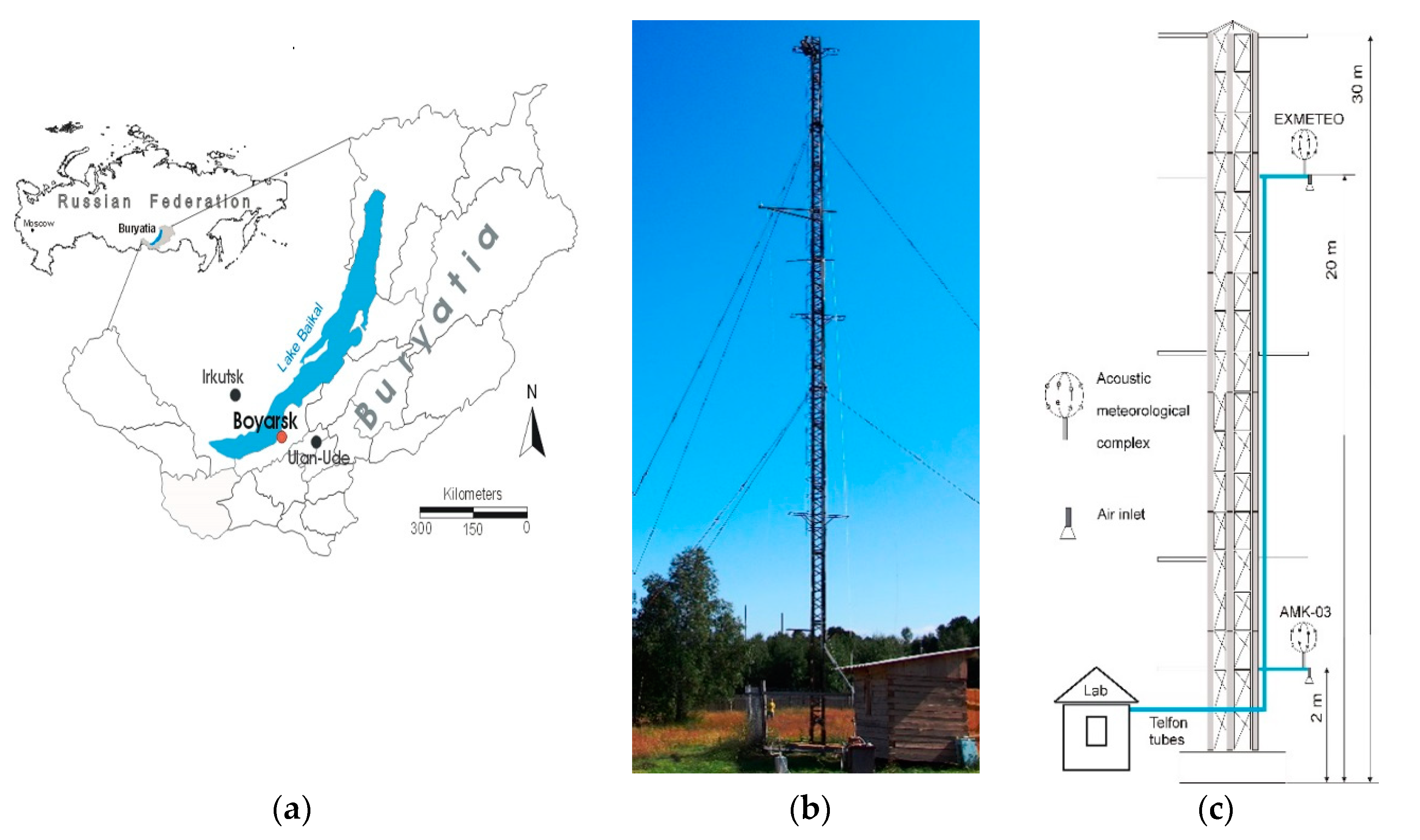
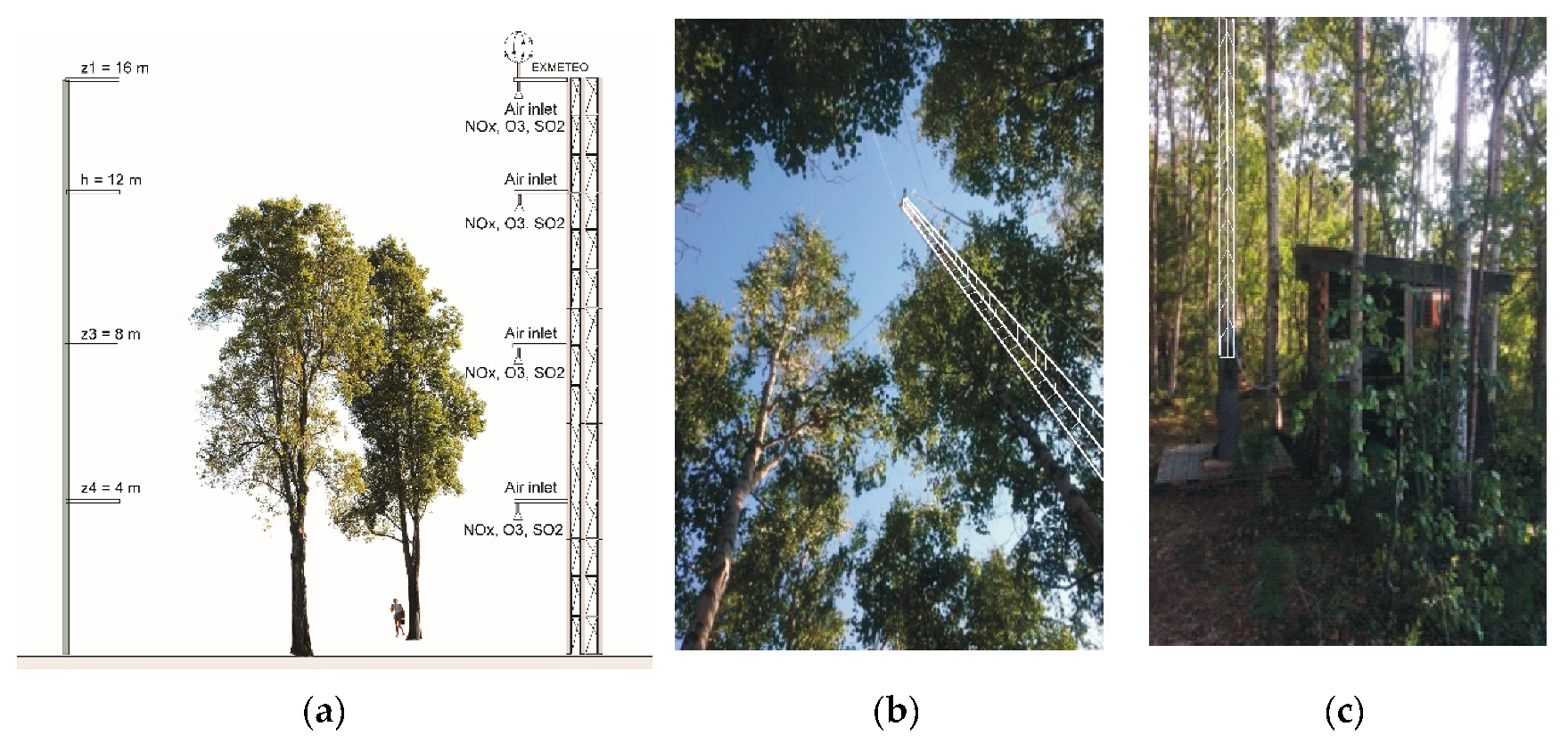
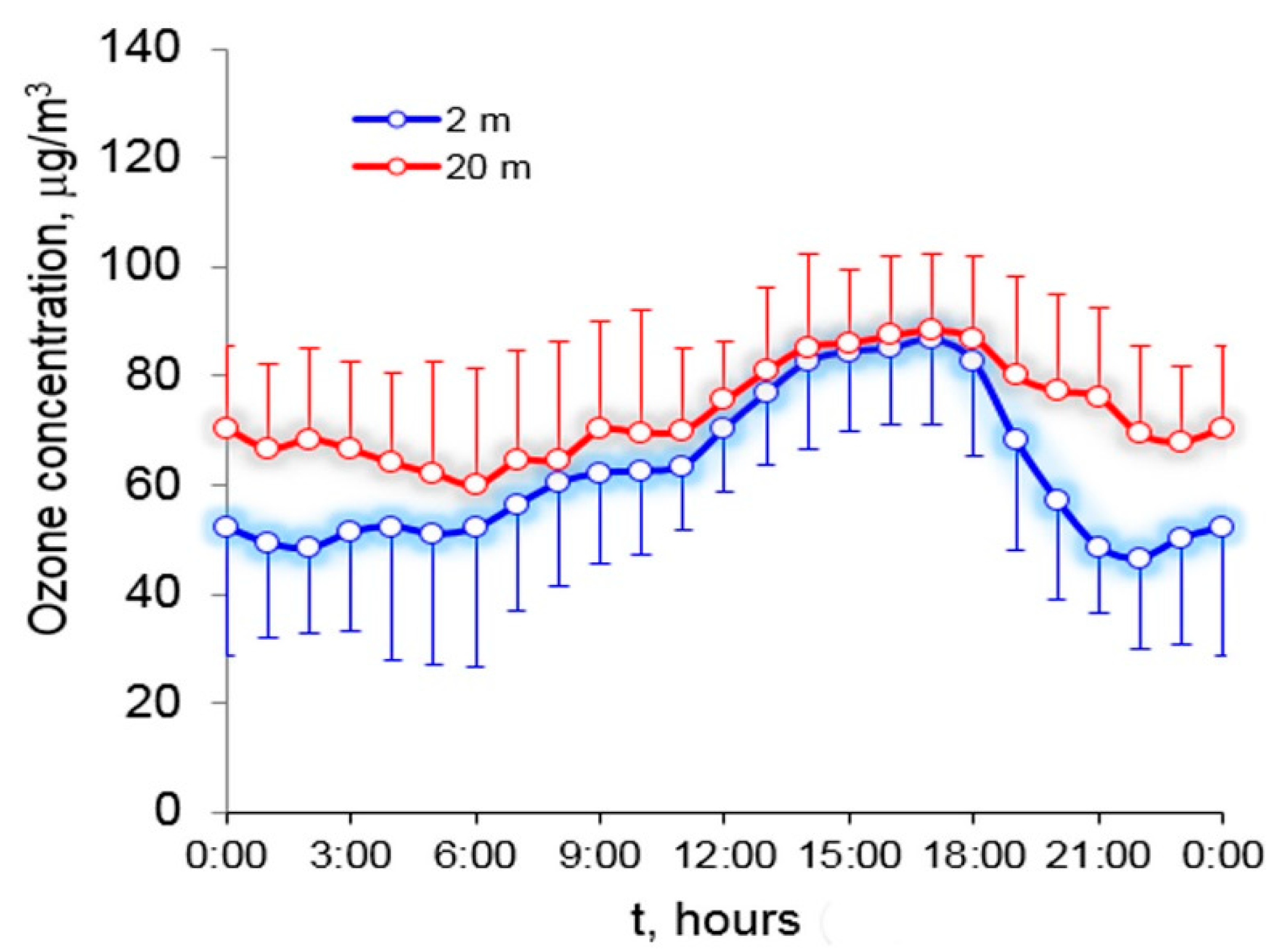
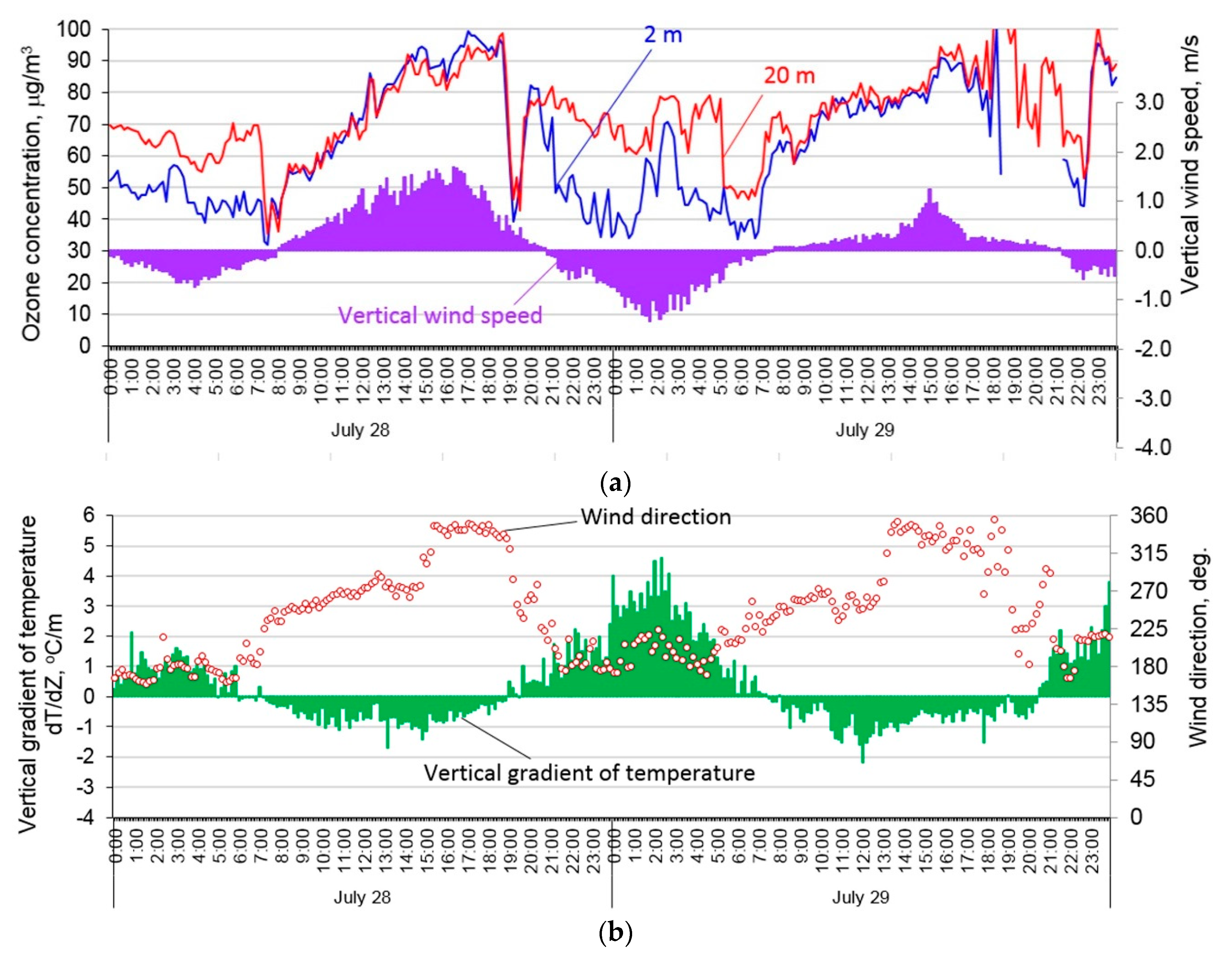
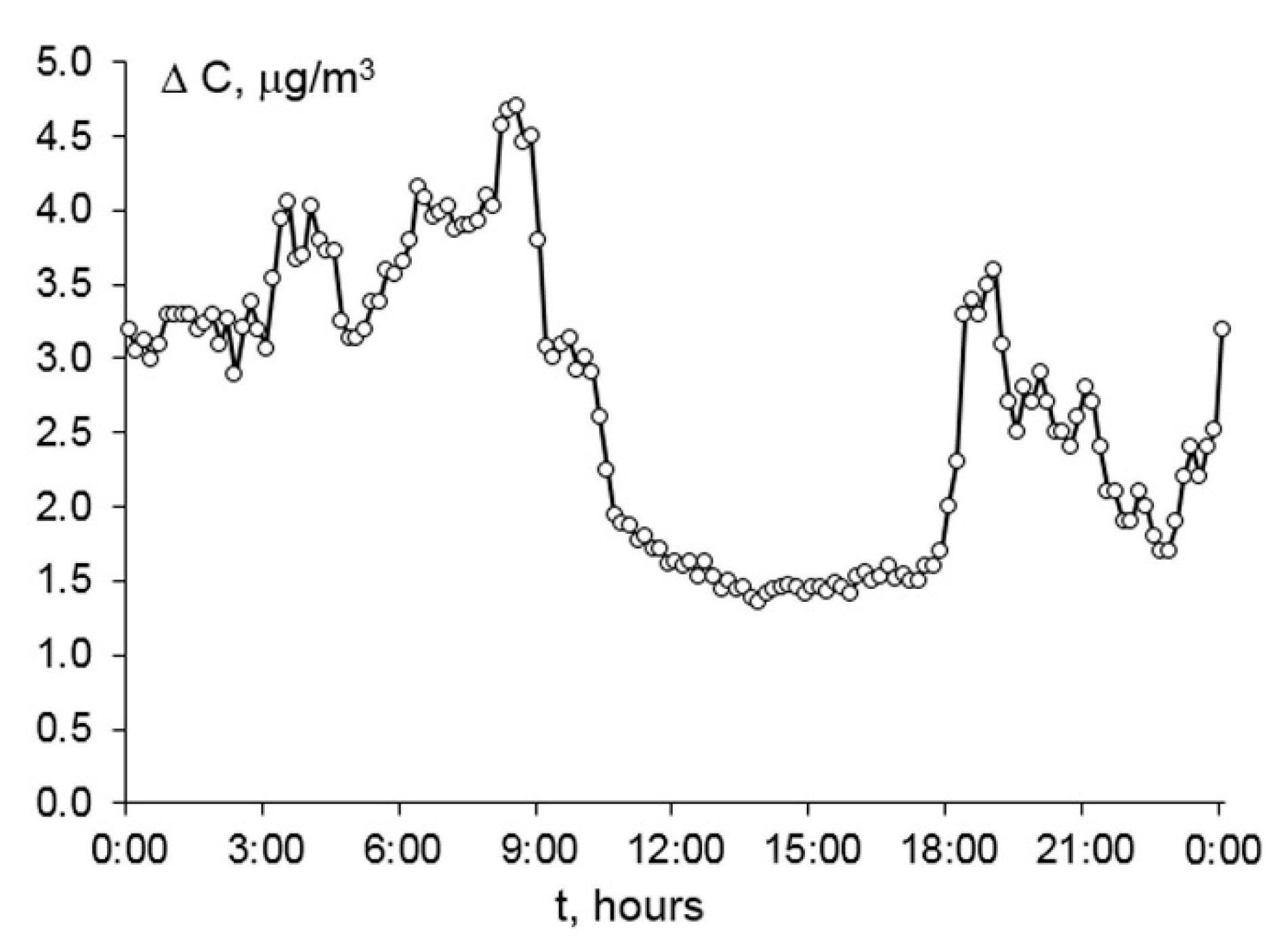
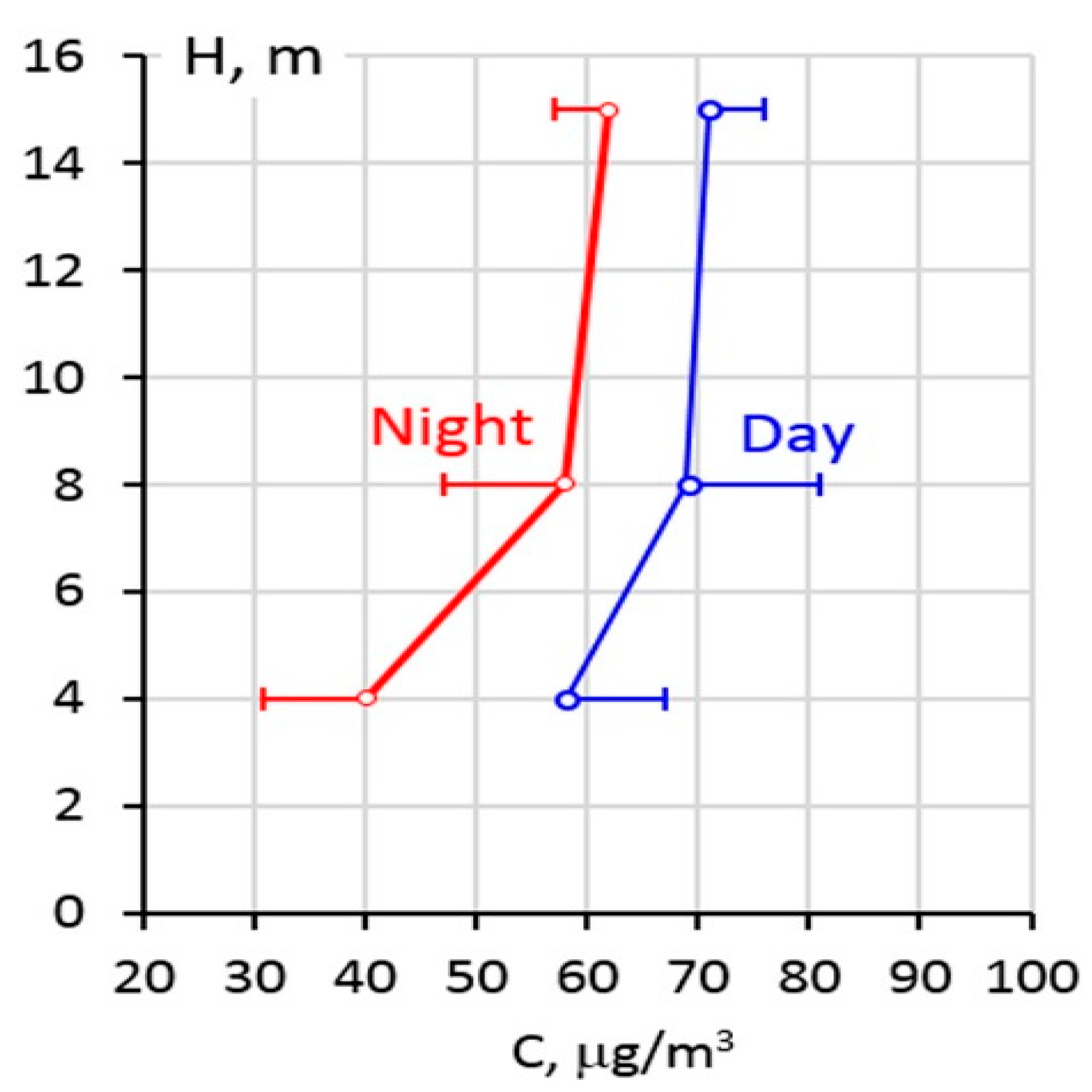
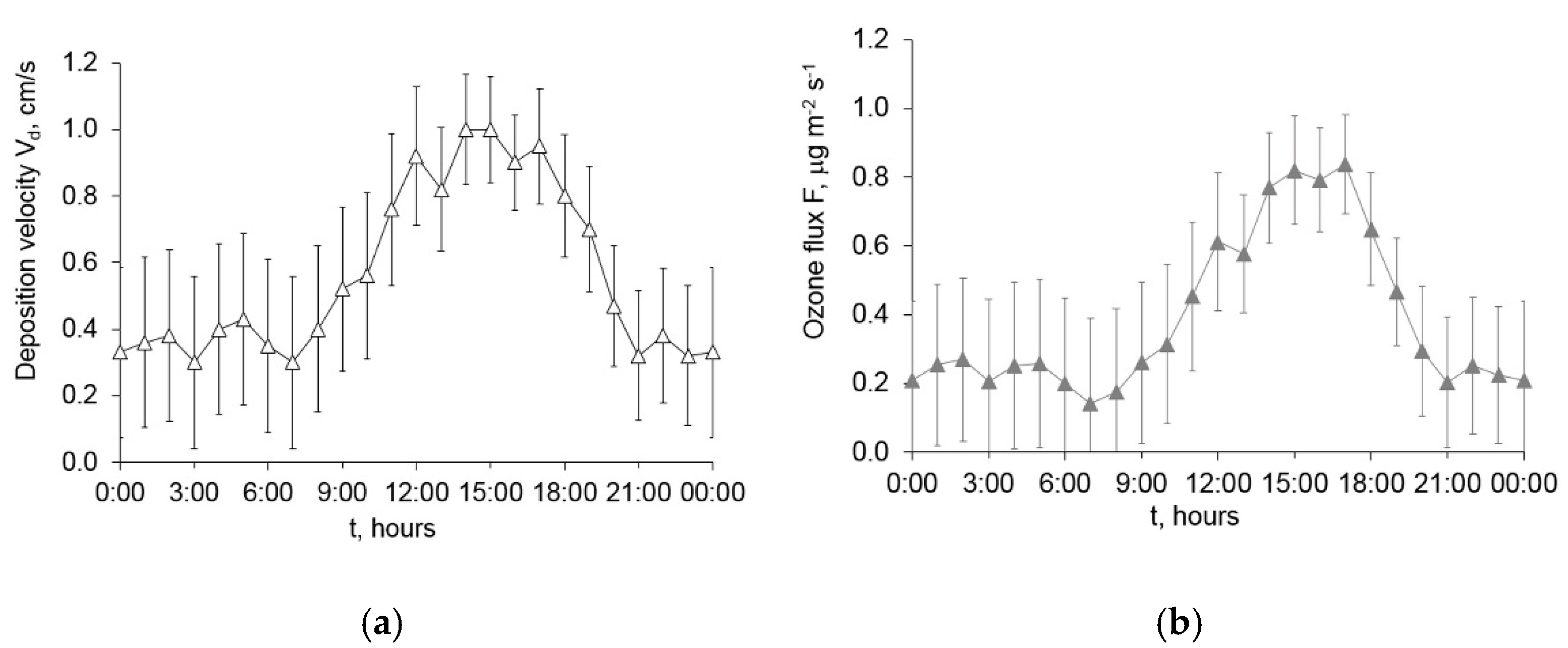
| Parameter | 28 July | 29 July | ||
|---|---|---|---|---|
| Night | Day | Night | Day | |
| Vd, cm/s | 0.14 | 0.29 | 0.16 | 0.34 |
| F, g m−2 s−1 | 0.067 | 0.190 | 0.080 | 0.210 |
| Parameter | Unit | Parameter Values |
|---|---|---|
| Canopy height (h) | m | 12 |
| Leaf Area Index (LAI) | - | 5.0 |
| Planar displacement (d) | m | 9.48 |
| Roughness length (z0) | m | 0.78 |
| Wind extinction coefficient (α) | m | 6.95 |
| Parameter | Night | Day |
|---|---|---|
| Vd, cm/s | 0.37 | 0.91 |
| F, g m−2 s−1 | 0.24 | 0.72 |
© 2019 by the authors. Licensee MDPI, Basel, Switzerland. This article is an open access article distributed under the terms and conditions of the Creative Commons Attribution (CC BY) license (http://creativecommons.org/licenses/by/4.0/).
Share and Cite
Zayakhanov, A.S.; Zhamsueva, G.S.; Tcydypov, V.V.; Balzhanov, T.S.; Dementeva, A.L.; Khodzher, T.V. Investigation of Transport and Transformation of Tropospheric Ozone in Terrestrial Ecosystems of the Coastal Zone of Lake Baikal. Atmosphere 2019, 10, 739. https://doi.org/10.3390/atmos10120739
Zayakhanov AS, Zhamsueva GS, Tcydypov VV, Balzhanov TS, Dementeva AL, Khodzher TV. Investigation of Transport and Transformation of Tropospheric Ozone in Terrestrial Ecosystems of the Coastal Zone of Lake Baikal. Atmosphere. 2019; 10(12):739. https://doi.org/10.3390/atmos10120739
Chicago/Turabian StyleZayakhanov, Alexander S., Galina S. Zhamsueva, Vadim V. Tcydypov, Tumen S. Balzhanov, Ayuna L. Dementeva, and Tamara V. Khodzher. 2019. "Investigation of Transport and Transformation of Tropospheric Ozone in Terrestrial Ecosystems of the Coastal Zone of Lake Baikal" Atmosphere 10, no. 12: 739. https://doi.org/10.3390/atmos10120739
APA StyleZayakhanov, A. S., Zhamsueva, G. S., Tcydypov, V. V., Balzhanov, T. S., Dementeva, A. L., & Khodzher, T. V. (2019). Investigation of Transport and Transformation of Tropospheric Ozone in Terrestrial Ecosystems of the Coastal Zone of Lake Baikal. Atmosphere, 10(12), 739. https://doi.org/10.3390/atmos10120739





